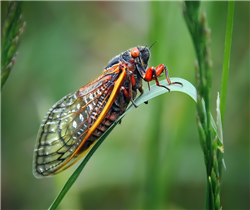 Purdue University - Extension - Forestry and Natural Resources
Purdue University - Extension - Forestry and Natural Resources
Got Nature? Blog
FORT WAYNE, Ind. (WANE 15): You have cicada questions, we have answers. WANE 15 spoke to Dr. Elizabeth Barnes, the Exotic Forest Pest Educator at Purdue University, to help answer questions about the Brood X cicadas. She offers her knowledge and expertise looking back on this year’s emergence.
Why did some locations not see the Brood X cicadas?
There are three main explanations why a given location did not see the Brood X cicadas this year. First, it is possible a place does not have a good cicada habitat. Second, it is possible a location used to be a good cicada habitat, but construction and human development since the last emergence of the Brood X cicadas 17 years ago has made the habitat no longer suitable; their food source could have been removed. The last explanation is what scientists are interested in figuring out: why did an area that saw cicadas 17 years ago not see them this year?
Researchers are working on papers to understand which explanations are the most plausible for this last category. It is the goal to have confirmed answers within the next one to two years. A Citizen Science mapping program is also being conducted to help uncover where the cicadas emerged this year and answer the question of where they are and are not located.
Is there a connection to the weather?
The peak emergence period for the Brood X cicadas is normally from late April through early June, but can still occur from the beginning of April to late June. This is during a stretch of spring that typically features big swings in the weather conditions. The Brood X cicadas usually need temperatures eight inches below the ground to reach 65 degrees before they start to emerge. They also like to emerge right after a warm rain. The cicadas are not impacted by the severity of the winter and the heat and humidity of the summer.
This year, it was a warm start to the spring. Dr. Barnes says reports of cicada holes near the surface were received early in the spring, indicating the Brood X cicadas were on the cusp of emerging in early to mid-April. High temperatures in Fort Wayne were in the 70s to 80s from April 4th to April 10th. Rainfall of 0.43 inches was recorded on the last day of this stretch. However, by later in the month, temperatures plummeted, with highs in the lower 40s on April 20th and April 21st. A snowfall of 4.2 inches occurred on April 20th.
Resources:
17 Ways to Make the Most of the 17-year Cicada Emergence, Purdue College of Agriculture
Ask an Expert: Cicada Emergence Video, Got Nature? Blog, Purdue Extension-FNR
Periodical Cicada in Indiana, The Education Store, Purdue Extension resource center
Cicada Killers, The Education Store
Elizabeth Barnes, Exotic Forest Pest Educator
Purdue University Department of Entomology
Nathan Gidley, Meteorologist
WANE 15, wane.com

Recent Posts
- Report Spotted Lanternfly – Purdue Landscape Report
Posted: April 10, 2024 in Alert, Forestry, Invasive Insects, Plants, Wildlife, Woodlands - Declining Pines of the White Variety – Purdue Landscape Report
Posted: in Alert, Disease, Forestry, Plants, Wildlife, Woodlands - Are you seeing nests of our state endangered swan? – Wild Bulletin
Posted: April 9, 2024 in Alert, Forestry, How To, Wildlife - Cicadas in Spring! – Purdue Landscape Report
Posted: in Forestry, Plants, Safety, Wildlife - New Deer Impact Toolbox
Posted: April 7, 2024 in Forestry, Land Use, Plants, Publication, Safety, Wildlife, Woodlands - 2024-25 Fishing Guide now available – Wild Bulletin
Posted: April 4, 2024 in Alert, Aquaculture/Fish, Aquatic/Aquaculture Resources, How To, Ponds, Wildlife - Help Research Chronic Wasting Disease – Wild Bulletin
Posted: April 3, 2024 in Disease, Forestry, How To, Safety, Wildlife, Woodlands - Indiana Reptiles and Amphibians – IFWOA Webinar
Posted: April 1, 2024 in Forestry, How To, Webinar, Wildlife, Woodlands - Birding through the Seasons – IFWOA Webinar
Posted: in Forestry, How To, Webinar, Wildlife, Woodlands - Look Out for Invasive Carp in Your Bait Bucket – Wild Bulletin
Posted: March 31, 2024 in Alert, Aquaculture/Fish, Aquatic/Aquaculture Resources, Invasive Animal Species, Wildlife
Archives
Categories
- Alert
- Aquaculture/Fish
- Aquatic/Aquaculture Resources
- Ask the Expert
- Christmas Trees
- Community Development
- Disease
- Drought
- Forestry
- Forests and Street Trees
- Gardening
- Got Nature for Kids
- Great Lakes
- How To
- Invasive Animal Species
- Invasive Insects
- Invasive Plant Species
- Land Use
- Natural Resource Planning
- Nature of Teaching
- Plants
- Podcasts
- Ponds
- Publication
- Safety
- Timber Marketing
- Uncategorized
- Urban Forestry
- Webinar
- Wildlife
- Wood Products/Manufacturing
- Woodland Management Moment
- Woodlands
